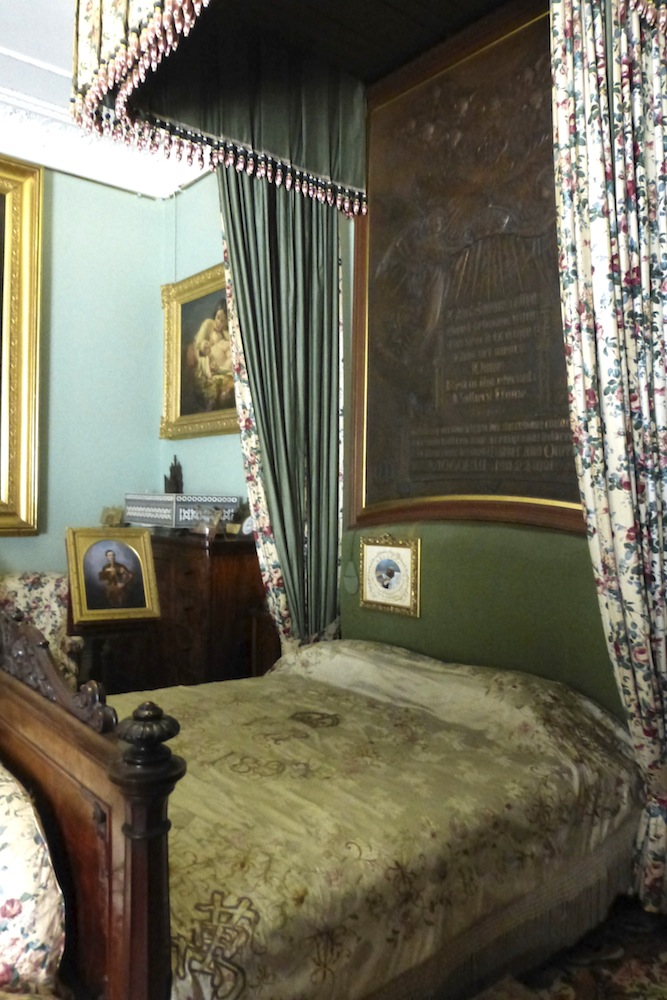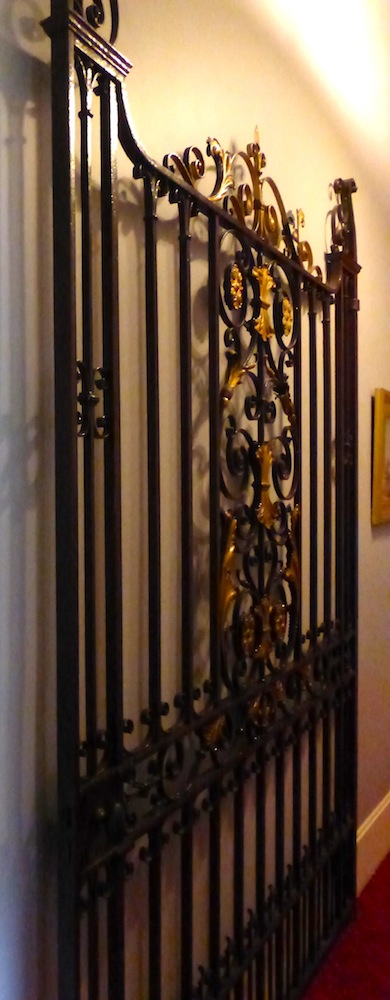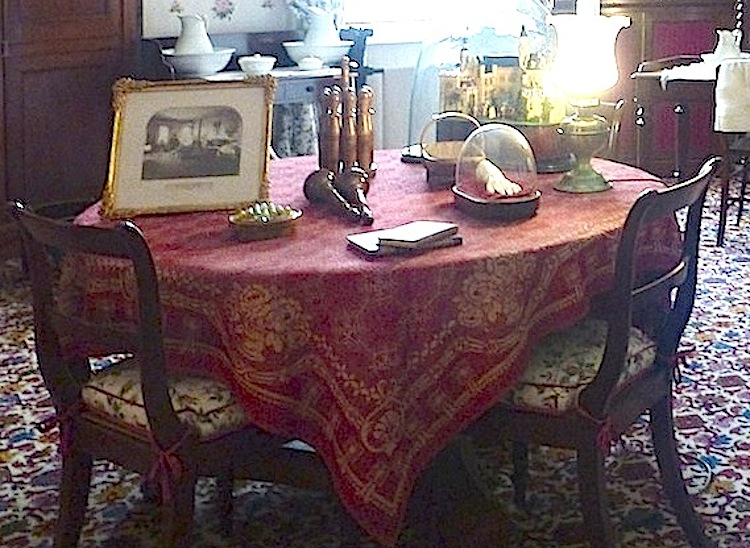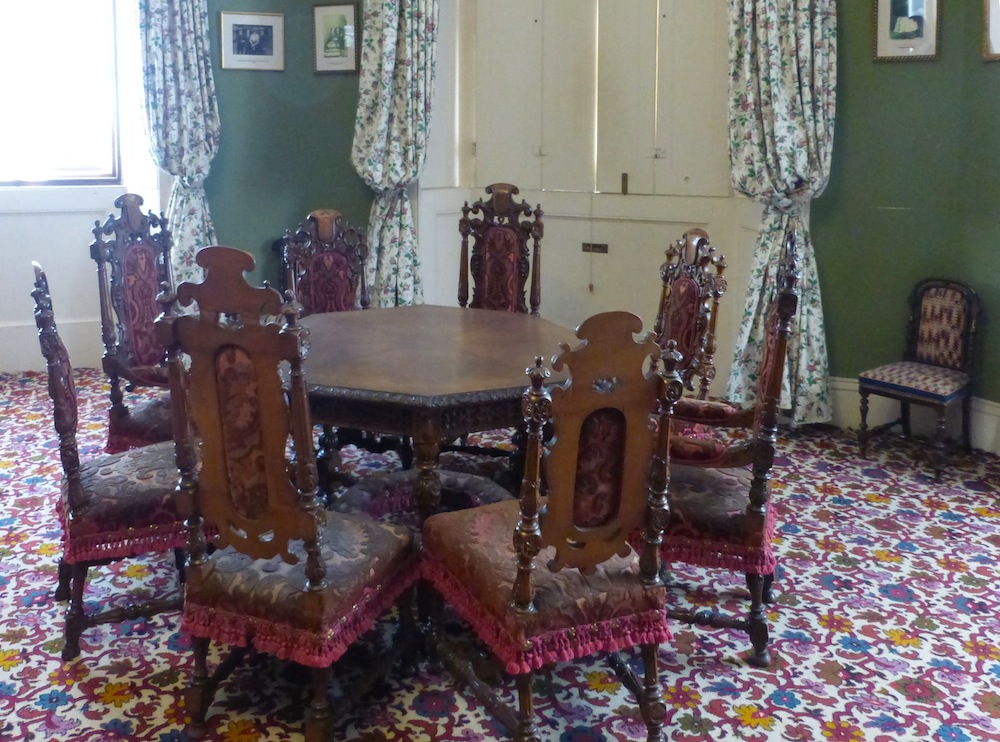Photographs by the author, with special thanks to English Heritage for permitting photography in Osborne House, and for allowing the photographs to be shared on a non-commercial basis. You may use the images without prior permission for any scholarly or educational purpose as long as you (1) credit the photographer and (2) link your document to this URL or cite it in a print document. [Click on all the images to enlarge them.]
Reception Rooms


Left: The entrance to the dining room, where dishes would be placed on a large sideboard under these paintings. Right: Part of the drawing room.
As the royal family's private space, the Pavilion was the first part of Osborne to be completed, in 1845. Like the exterior of this Grade I listed building, the interior was very much a collaborative affair. With Prince Albert (1819-1861) working closely with him, the architect and builder Thomas Cubitt (1788-1855) brought many features, such as fireplaces, doors and "basic equipment for sanitation and water supply" (Lloyd and Pevsner 45) from his own workshops and stores, which supplied other grand houses that he built. Cubitt provided the patterns for much of the decorative plasterwork as well. But the interior decoration of these rooms, especially the splendid ceilings of the reception rooms on the ground floor, also owed a good deal to the Queen's adviser in artistic matters, Ludwig Grüner (1801-1882). Grüner had these ceilings more richly repainted in 1857 (see Lloyd and Pevsner 208).
"The dining, drawing and billiard rooms are the main reception rooms in the Pavilion" (Turner 8). In the dining room hangs Franz Winterhalter's large painting of the royal family and, to its left, a painting of Queen Victoria's mother, the Duchess of Kent. The drawing room, which leads off the dining area, is where the Queen would relax and sometimes play the piano after dinner, or listen to the recitals that were sometimes held here. The beautiful tulip-veneered grand piano was made for Prince Albert by Erard, in about 1848. Both these rooms have large bay windows and are full of light.


Left to right: (a) A typical surface in the drawing room, covered with ornaments. (b) The billiard room ceiling, with entwined initials for Victoria and Albert around the central part.
Among the many framed pictures, vases, ornaments and sculptures in the drawing room are miniatures of each of the royal couple's children by Mary Thornycroft — such as the one shown on the left above, of the infant Princess Beatrice cradled in a nautilus shell (Turner 8). The billiard room was the third reception room. This is where the Queen learned to play billiards.
First Floor Rooms



Left to right: (a) Queen Victoria's desk in her sitting room. (b) A hand-crafted spinning wheel in the sitting room. (c) Prince Albert's dressing and writing room.
On the first floor were the Queen's sitting room, dressing room and bedroom, while Prince Albert's dressing and writing room, and bathroom with up-to-the-minute plumbed-in facilities, were on the opposite side. The sitting room has a wide bay with a covered balcony, giving extensive views over the Pavilion terrace, right out across the grounds, to the Solent. This is where the royal couple worked on their dispatches, with the Queen's desk on the left, and Prince Albert's on the right. The homely spinning wheel in this room was a gift to the Queen from the Duchess of Athole in 1866 (Turner 17). Prince Albert's dressing and writing room was kept unchanged after his death, even to the extent that servants continued to bring hot water to it at the appointed time, as if he was still alive.




Left: The dressing table in the Queen's dressing room. (b) Queen Victoria's bedroom. (c) and (d) One of the wrought-iron gates outside the bedroom.
Here in the Queen's dressing room can be seen her "fine Minton porcelain dressing table set commissioned by Prince Albert as a Christmas present in 1853" (Turner 18). In the Queen's bedroom, washing and toilet facilities are cleverly concealed, and perhaps this is why it seems even more "surprisingly small" than the other private rooms (Stewart 77). It was on a couch-bed here that Queen Victoria died with her family around her. Over the bed is a memorial bronze which Queen Alexandra helped to design: the room became a family shrine, and Edward VII placed fine decorative gates outside to maintain privacy (Turner 19). The ground floor reception rooms were opened to the public as early as 1904, but these private apartments were not opened until 1955, after royal permission had been granted in the previous year (see Lloyd and Pevsner 202, and "History").
The Nursery


Left: The nursery bedroom. Right: Low table and chairs, also in the nursery bedroom.
With the royal family growing rapidly, a nursery suite for the smaller children (up to the age of about six) was an important part of the Pavilion. On the third floor, it had cots for the children and a bed for their nurse. The swing cot was made for the eldest daughter Vicky in 1840 (Turner 13).

More elaborate table and chairs in the nursery sitting-room.
Related Material
- The Swiss Cottage and other children's structures at Osborne
- Osborne: Exterior
- Osborne: Main Wing
- Osborne: Durbar Wing
- Osborne: Terraces and Grounds
- Sculpture of Eos on the Pavilion terrace
- Queen Victoria's bathing machine at Osborne beach
Bibliography
"Erard: Grand Piano, c.1848." Royal Collection Trust. Web. 10 September 2017.
"History of Osborne." English Heritage. Web. 10 September 2017.
Lloyd, David W., and Nikolaus Pevsner. Isle of Wight. Buildings of England series. New Haven & London: Yale University Press, 2006.
"Osborne House, East Cowes." British Listed Buildings. Web. 10 September 2017.
Stewart, Jules. Albert: A Life. London & New York: I. B. Tauris, 2011 [Review].
Turner, Michael. Osborne. Rev. reprint. English Heritage, 2016.
Created 10 September 2017